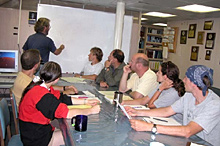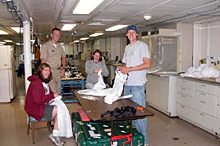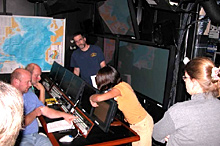
Chief Scientist Les Watling, University of Maine leads a planning discussion among the science team. Click image for larger view.
Be Prepared
August 10, 2005
Pete Wiley
Web Coordinator
NOAA Office of Ocean Exploration
Planning for the seamount dives is in high gear while on our four-day transit to the Corner Rise Seamount chain. Many of the crew and science party have worked together before, but there are groups in the science party who have not been on previous cruises together as well as people who have never been on a cruise like this before. A significant amount of planning and preparation work must take place; in order ensure that individual project objectives are met as well as the overall expedition objectives.

Kate Buckman of the Woods Hole Oceanographic Institution, Sarah L’Heureux of the University of Delaware, and Alex Gagnon of the California Institute of Technology craft nets to be used in collecting specimens of coral fossils, while Junior Officer, Ensign James Brinkley looks on. Click image for larger view.

Pamela Lezaeta of the Institute for Exploration coordinates a review of operations in the control van while Timothy Shank, of the Woods Hole Oceanographic Institution, Peter Auster, of the University of Connecticut, Scott France, of the University of Louisiana, and Celeste Mosher, of the University of Maine look on. Click image for larger view.
Another important task is the coordination of gathering samples and video required by each program participating on the cruise. The science team has created a “shopping list” for all the programs that include the various samples and the numbers of each, that will hopefully be collected. Additionally, details like the need to keep specimens separate, and the logistics involved in collecting water salinity and temperature data are coordinated. The need for communication between ROV operations and the command of the ship is also critical. This is true both during the dive, when the ships position must by synchronous with the movement of the ROVs and also in movement from site to site, which the ship’s command must plan for.

Timothy Shank of the Woods Hole Oceanographic Institution, David Lovalvo of the Institute for Exploration (IFE), and David Wright of IFE work on modifications to the ROV Hercules. Click image for larger view.
In addition to the dive operations, the personnel responsible for other various functions need to ensure that everything is in place. Allen Gontz of the University of Massachusetts – Boston is leading the effort to conduct mutlibeam surveys of the seamount sites, which produce detailed maps of potential dive areas. The vehicle team is making changes from previous dives to ensure that sample collection and storage are conducted in the most effective way. Sample collection techniques are tweaked based on the experience gleaned from previous expeditions. Watch schedules need to be planned, taking into consideration how people work best (the operations run 24 hours a day while on the dive sites) and to ensure appropriate coverage in terms of project interests and expertise. Each of these activities is critical to the successful completion of the mission.
Sign up for the Ocean Explorer E-mail Update List.
























